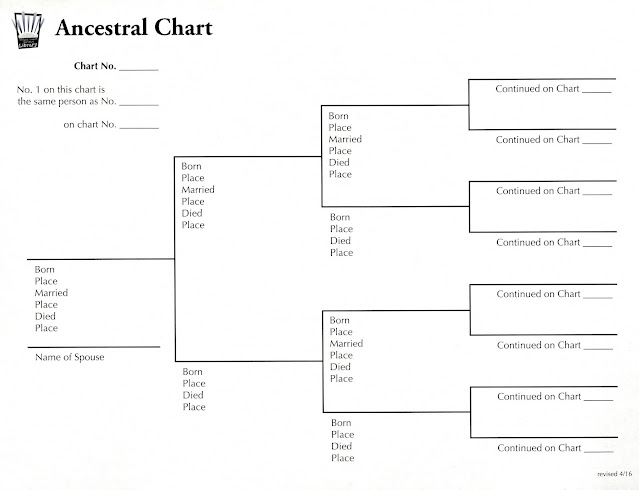Ancestor Charts
Ancestor charts, family trees, pedigree charts, lineage charts...
Today, we are going to look at:
- What are Ancestor Charts?
- Why are they important?
- How do you properly fill them out?
What is an Ancestor Chart?
An Ancestor chart records the direct line of individuals from whom you descend - those for whom you intend to compile a complete and correct family history.
OR
As the Dictionary Genealogical and Archaic Terms from Rootsweb would define it:
"ANCESTOR CHART - report or chart that shows a person and all of their ancestors in a graphical format."
If you're new to genealogy, you may have heard about ancestor charts and may have even seen a few of them, but still don't understand why they are important to your research.
Here's WHY ancestor charts are important to your research:
- They organize the known information on multiple generations of a family line in one place.
- They reveal what information is missing and what still needs to be researched.
- They are easy to share with others.
- They serve as aids when asking other for research help.
- They can be a decorative display of your family history.
Five Generation Ancestor Chart for Theodore Roosevelt.
 |
| Chart found on the Famous Kin website. Notice the red box? Some information is missing and would need further research. |
A decorative ancestral chart
 |
| This is a decorative antique Nantucket Family Tree. Image from Boston Rare Maps |
How to properly fill in an Ancestral Chart
Four Generation Ancestral Chart - This is a simple ancestral chart that we will be using this to explain the basics of how to fill in an ancestor chart.
But first...
Some Guidelines for Filling in the Chart:
- Use a pencil to fill in the information so that it can be corrected as new information is discovered.
- Last names, also called surnames, are written in ALL CAPS to make them easier to pick out when browsing a document.
- Women are always listed under their maiden names.
- Dates are entered from smallest unit to larger, day/month/year, as in 23/7/1979 - this looks strange to Americans who use the format month/day/year 7/23/1979
- I prefer writing out or abbreviating the month as 23 Jul. 1979 or 23 July 1979
- ALWAYS use four digits for the year. As you work back in time, you work in multiple centuries. 2000's, 1900's 1800's and so on.
- Places are also listed from the smallest unit to the larger unit; city or township/county/state/country as in Seville, Guilford Township, Medina County, OH, USA.
- Use standard abbreviations for state names, etc., or provide a key to what abbreviations you use.
Filling in the 4 generation Ancestral Chart
First, fill in the chart number. Start with number 1.
The individual whose ancestral line is being researched puts their name on the line to the far left.
Then the mother's name is added...
You start with the father's father, the paternal grandfather.
Then the father's mother, or paternal grandmother.
Next is the mother's father, or maternal grandfather, and then the mother's mother, the maternal grandmother.
Moving again to the right, we reach the fourth generation, the great-grandparents.
The fields "Born", "Married" and "Died" are for the dates for those events:
Not surprisingly the place is for location for those events:
The marriage information for John MASON and Sarah TANNER is missing. This event needs further research before it can be added to the chart.
Lastly, did you notice that the great-grandparents have a line "Continued on Chart ___"
Your research keeps working its way into the past. Once you move into the great grandparents, you'll need to create another ancestor chart. From the example above, George JOHNSON is continued on Chart No. 2.
You can use ancestral charts to organize and document as many generations as you need to.
Start filling out your ancestor charts today!
- me-team.genealogy@mcdl.info OR call
- 330-725-0588 ext. 5017
Don't forget to bring an Ancestral Chart with you! We can work on filling it out together.
Watch for future instructional videos from your
Medina County District Library's Genealogy Team.






















No comments:
Post a Comment